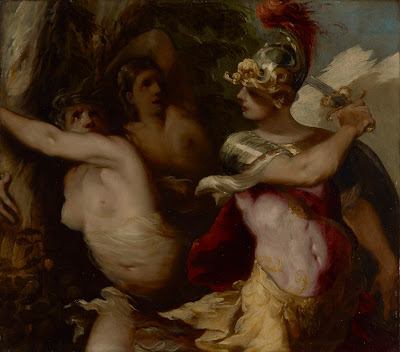 |
| Scarsellino Discovery of Coral ca. 1605 oil on copper private collection |
 |
| Scarsellino Virgin adored by Saints ca. 1609 oil on copper Metropolitan Museum of Art, New York |
 |
| Annibale Carracci Stoning of Stephen 1603-04 oil on copper Louvre |
"There are certain basic similarities between the Christian discourse on sex and the Christian discourse on images. With the exception of an enlightened ascetic few, the vast majority of ordinary people are irremediably drawn to images, as they are to sex; those theologians who did not adhere to a rigorist position of complete abstention (or, mutatis mutandis, aniconism) had to remain content with setting guidelines that would keep this potentially explosive activity within licit bounds, and even guide it to productive purposes. . . . In his 1522 treatise, the first iconoclastic battle cry of the Reformation, Andreas Karlstadt had made much hay out of passages in Ezekiel 6 and 16 in which the prophet excoriates his community for becoming whores to their idols, "for Scripture calls such venerators of images whores and adulterous women, and such deceitful images men." At a basic level the metaphor of adultery and promiscuity was simply a way of describing the basic betrayal of one god for many. But Ezekiel makes it clear that it also has to do with the nature of the encounter with the images themselves: in idolatry the image becomes protruberant, active, and male; the viewer is feminized as the whore, letting the idols have their way with "her." . . . Rehearsing a venerable list of legitimate uses for images, Johannes Eck, in his 1522 reply to Karlstadt's call for iconoclasm, explained that they were beneficial as means to instruct, to propagate the memory of the saints and their imitation by the faithful, and to move the faithful to devotion, emphasizing that such proper use depends on maintaining a distance "between the image and what it represents" – that is, on understanding that "the cult, veneration, and respect shown to an image does not go to the image itself but to the archetype; to that which is represented." To use images in other ways – to direct worship to the image itself – was idolatry; it was to enter into relations with the flesh of the image, as it were, and was consistently associated with wantonness, adultery, fornication, and whoring. . . . Anticipating Eck's argument, Karlstadt rejects the "prophylactic" defense of image worship. Don't claim, he says, that you are not venerating the material image but only what it represents, because God knows that when people make images they develop feelings for them in their hearts. Karlstadt is pointing to a real weakness in the legitimation argument, for, after all, the images that recommend themselves most effectively to the memory are the most striking ones, and the ones capable of stirring the viewer are by definition the ones that make the most powerful claims on his or her emotions. For Karlstadt, the means of making images legitimate are also a source of their dangerous power."
– from The Controversy of Renaissance Art by Alexander Nagel (University of Chicago Press, 2011)
 |
| Giovanni Lanfranco Annunciation ca. 1615-16 oil on copper Hermitage, Saint Petersburg |
 |
| Cristofano Allori Annunciation before 1621 oil on copper Hermitage, Saint Petersburg |
 |
| Pier Francesco Mola Rest on the flight into Egypt 1640s oil on copper Metropolitan Museum of Art, New York |
 |
| Giacomo Cavedone Ascension of Christ ca. 1640 oil on copper Los Angeles County Museum of Art |
 |
| Giovanni Francesco Romanelli St John and St Peter at Christ's Tomb ca. 1640 oil on copper Los Angeles County Museum of Art |
 |
| Giovanni Francesco Romanelli Madonna and Child under an apple tree 1644 oil on copper Hermitage, Saint Petersburg |
 |
| Alessandro Turchi Lamentation with the Magdalene and three Angels before 1649 oil on copper Hermitage, Saint Petersburg |
 |
| Francesco Maffei Rinaldo and the Mirror-Shield ca. 1650-55 oil on copper Getty Museum, Los Angeles |
 |
| Francesco Maffei Rinaldo's Conquest of the Enchanted Forest ca. 1650-55 oil on copper Getty Museum, Los Angeles |
 |
| Sassoferrato Holy Family before 1685 oil on copper Hermitage, Saint Petersburg |
 |
| Luca Giordano St John the Baptist preaching ca. 1695 oil on copper Los Angeles County Museum of Art |